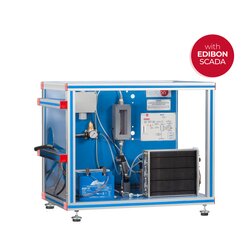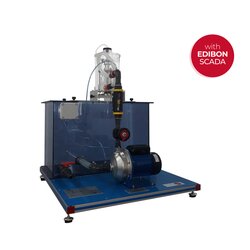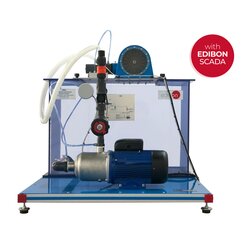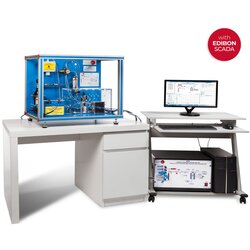Smart Grid Power System with power generation, transmission, distribution and loads, with Scada (AEL-CPSS-01S)
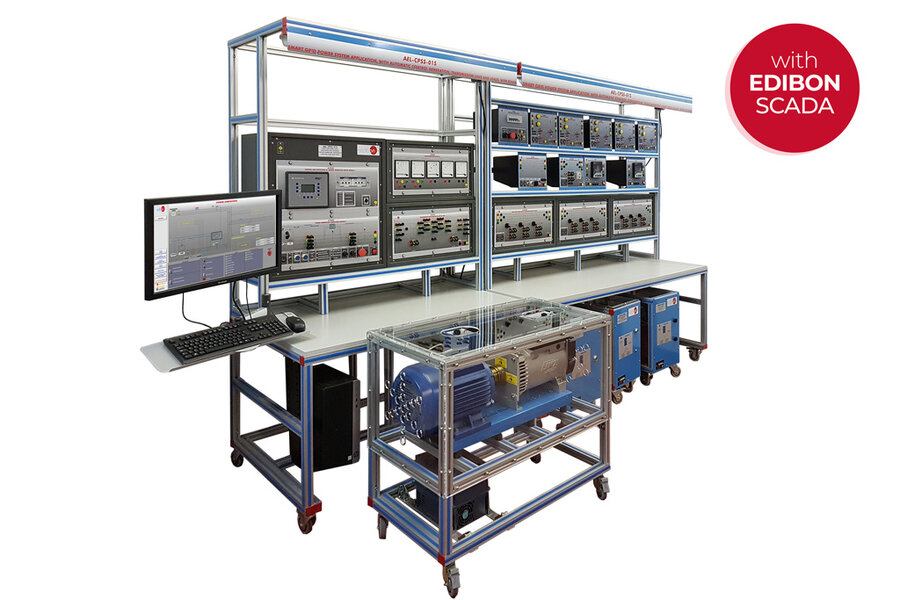


PL-469329
The Smart Grid Power System with Power Generation, Transmission, Distribution, and Loads, with SCADA, “AEL-CPSS-01S”, developed by EDIBON, is a comprehensive training system designed for both theoretical and practical education in power generation, transmission, distribution, consumption, protection relays, and micro-grids. This application provides a deep understanding of the key principles involved in the operation and control of power systems, including the interconnected areas of generation, transmission, distribution, and load consumption.
The AEL-CPSS-01S application offers various levels of training to ensure users gain both theoretical knowledge and practical experience. The included manual covers a wide range of topics, from the basic functioning and control of electric generators to energy transmission and consumption in high-voltage power systems. Alongside the manual, a series of modules are available for hands-on application, allowing users to practice and apply the theoretical knowledge they have acquired.
One of the key advantages of this system is its modularity and flexibility, which enables users to configure different real-world power system setups. For example, users can design and simulate a traditional power system comprising Generation + Transmission/Distribution + Consumption, or a micro-grid system with Generation + Consumption, even operating in a stand-alone mode. At any point, the user can synchronize the electric generator with the laboratory mains and develop a real energy distribution network.
In terms of functionality, the entire system can be controlled both locally—using switches, breakers, and signals—and remotely through Data Acquisition and Control Software. The system also includes AEL-CPSS-01S/CCSOF (Data Control and Data Acquisition Software), which provides remote control capabilities for the power system..
AEL-WPPIC
- AEL-CPSS-01S. Application:
- N-ALI01. Industrial Main Power Supply Module.
- N-PPIM2. Instrumentation Module 2.
- N-PSUB3. Power Generation Substation Module 3.
- N-EALD. Network Analyzer Module with Oscilloscope and Data Acquisition.
- N-BUS08. Distribution Busbar Module.
- N-BUS09. Coupling Busbar Module.
- N-AE1CD. Transmission Lines Simulation Digital Module.
- N-REG16. Voltage Regulation Module 1.
- TRANS3/5KRM. Three-phase Autotransformer with Motor Voltage Regulator.
- TRANS3/5KGR. Three-phase Grid Transforme.
- TRANS3/5KSU. Three-phase Step-up Transformer.
- N-ERP-MF01. Digital Fault Simulator Module.
- N-CAR19T3D. Three-phase Digital Bank of Commutable Capacitors Module.
- N-CAR35T3D. Three-phase Digital Bank of Commutable Resistors Module.
- N-CAR36T3D. Three-phase Digital Bank of Commutable Inductances Module.
- GMG4.5K3PH. 4.5 KW Generator-Motor group.
- AEL-WBMP. Electrical Workbench (Mobile Small).
- AEL-WBMG. Electrical Workbench (Mobile Big).
- All necessary cables to realize the practical exercises are included.
Required elements (Not included):
- AEL-PC. Touch Screen and Computer.
Additional recommended elements (Not included):
- PSV-BPP-SOF. Biomass Power Plants Simulator.
- PSV-GPP-SOF. Geothermal Power Plants Simulator.
- PSV-GSPP-SOF. Gas Power Plants Simulator.
- PSV-HPPS-SOF. Hydroelectric Power Plants Simulator.
- PSV-HSPP-SOF. Heliothermic Solar Power Plants Simulator.
- PSV-WPPP-SOF. Wind Powered Power Plants Simulator.
- TPEL/1800W. Three-Phase DC/AC Electronic Load of 1800 W.
The complete unit includes as well:
- Advanced Real-Time SCADA.
- Open Control + Multicontrol + Real-Time Control.
- Specialized EDIBON Control Software based on LabVIEW.
- National Instruments Data Acquisition board.
- Calibration exercises, which are included, teach the user how to calibrate a sensor and the importance of checking the accuracy of the sensors before taking measurements.
- Projector and/or electronic whiteboard compatibility allows the unit to be explained and demonstrated to an entire class at one time.
- Capable of doing applied research, real industrial simulation, training courses, etc.
- Remote operation and control by the user and remote control for EDIBON technical support, are always included.
- Totally safe, utilizing 4 safety systems (Mechanical, Electrical, Electronic and Software).
- Designed and manufactured under several quality standards.
- Optional ICAI software to create, edit and carry out practical exercises, tests, exams, calculations, etc. Apart from monitoring user’s knowledge and progress reached.
- This unit has been designed for future expansion and integration. A common expansion is the EDIBON Scada-Net (ESN) System which enables multiple students to simultaneously operate many units in a network.
- AEL-CPSS-01S. Computer Control + Data Acquisition + Data ManagementSoftware.
- Cables and Accessories, for normal operation.
- Manuals: This unit is supplied with 7 manuals. Required services, Assembly and Installation and Control software, Starting-up, Safety, Maintenance, Calibration and Practices manuals.
EXERCISES AND PRACTICAL POSSIBILITIES TO BE DONE WITH THE MAIN ITEMS
- Study of generation, transmission and distribution power systems.
- Analysis of the measurements of the power flows of the synchronous generator, transmission lines and loads.
- Analysis of the active and reactive power of the synchronous generator againts load variations.
- Automatic synchronization maneuvers of synchronous generator with the mains.
- Study of the synchronous generator in island operation mode.
- Study of the Micro-Grids.
- Study of the synchronous generator in grid parallel operation mode.
- Study of excitation/voltage regulation of synchronous generator in island mode.
- Study of turbine regulation (frequency control) in island mode.
- Study of excitation/voltage regulation of synchronous generator in parallel grid operation mode.
- Study of turbine regulation (frequency control) in parallel grid operation mode.
- Study of the power factor regulation of synchronous generator in parallel grid operation mode.
- Analysis and calculus of energy loses in transmission line according to the line electrical parameters.
- Capacitive effect influence in transmission lines.
- Analysis of the reactive energy excess in transmission lines.
- Analysis of the influence of one or more line losses in the electric system.
- Power factor compensation and the effects in the power system.
- Single-Pole, Two-Pole and three-Pole faults with and without impedance.
- Double busbar coupling maneuver.
- Operation logic with circuit breakers and disconnectors in a double busbar substation.
- Load sharing with different feeders.
- Busbar changeover without interruption
Some practical exercises possibilities with the SCADA:
- Remotely control of generation power systems.
- Analysis with the SCADA software of synchronous generator power flows.
- Analysis with SCADA software of active and reactive power of synchronous generator.
- Remotely control of manual synchronization of synchronous generator with the mains.
- Remotely control of automatic synchronization of synchronous generator with the mains.
- Remotely control of synchronous generator in island grid operation mode.
- Study of Micro-Grids.
- Remotely control of synchronous generator in parallel grid operation mode.
- Remotely control of excitation/voltage regulation of synchronous generator in island mode.
What is this?
These percentage scores are an average of 0 user reviews. To get more into detail, see each review and comments as per below
If you have used this product, support the community by submitting your review
